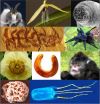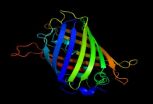(Press-News.org) TEMPE, Ariz. – The International Institute for Species Exploration at Arizona State University and a committee of scientists from around the world announced their picks for the top 10 new species described in 2011. This is the fifth year for the top 10 new species list, which was released May 23 to coincide with the anniversary of the birth of Carolus Linnaeus, the Swedish botanist who was responsible for the modern system of plant and animal names and classifications.
On this year's top 10 new species list are a sneezing monkey, a beautiful but venomous jellyfish, an underworld worm and a fungus named for a popular TV cartoon character. The top 10 new species also include a night-blooming orchid, an ancient walking cactus creature and a tiny wasp. Rounding out this year's list are a vibrant poppy, a giant millipede and a blue tarantula.
"The top 10 is intended to bring attention to the biodiversity crisis and the unsung species explorers and museums who continue a 250-year tradition of discovering and describing the millions of kinds of plants, animals and microbes with whom we share this planet," said Quentin Wheeler, an entomologist who directs the International Institute for Species Exploration at ASU.
Members of the international committee who made their selection from more than 200 nominations look for "species that capture our attention because they are unusual or because they have traits that are bizarre," said Mary Liz Jameson, an associate professor at Wichita State University who chaired the international selection committee. "Some of the new species have interesting names; some highlight what little we really know about our planet," she said.
Images and other information about the top 10 new species, including the explorers who made the discoveries and recorded them in calendar year 2011, are online at http://species.asu.edu. Also at the site is a Google world map that pinpoints the location for each of the top 10 new species. This year's top 10 come from Brazil, Myanmar, the Dutch Caribbean, South Africa, Papua New Guinea, Spain, Borneo, Nepal, China and Tanzania.
Describing the discoveries
Sneezing monkey: Since 2000, the number of mammals discovered each year averages about 36. So it was nothing to sneeze at when a new primate came to the attention of scientists conducting a gibbon survey in the high mountains of Myanmar (formerly Burma). Rhinopithecus strykeri, named in honor of Jon Stryker, president and founder of the Arcus Foundation, is the first snub-nosed monkey to be reported from Myanmar and is believed to be critically endangered. It is distinctive for its mostly black fur and white beard and for sneezing when it rains. A video of this species in on YouTube at http://www.youtube.com/watch?v=d1VuRvRv_UU.
Bonaire banded box jelly: This strikingly beautiful yet venomous jellyfish looks like a box kite with colorful, long tails. The species name, Tamoya ohboya, was selected by a teacher as part of a citizen science project, assuming that people who are stung exclaim "Oh boy!" A video of the species, which has been spotted near the Dutch Caribbean island of Bonaire, is on YouTube at http://www.youtube.com/watch?v=PcraphPLAxY.
Devil's worm: Measuring about 0.5 millimeters (1/50 or 0.02 inches) these tiny nematodes are the deepest-living terrestrial multicellular organisms on the planet. They were discovered at a depth of 1.3 kilometers (8/10 mile) in a South African gold mine and given the name Halicephalobus mephisto in reference to the Faust legend of the devil because the new species is found at such a depth in the Earth's crust and has survived immense underground pressure as well as high temperatures (37 degrees Celsius or 98.6 degrees Fahrenheit). According to its discoverers, carbon dating indicated that the borehole water where this species lives had not been in contact with Earth's atmosphere for the last 4,000 to 6,000 years.
Night-blooming orchid: A slender night stalker is one way to describe this rare orchid from Papua New Guinea whose flowers open around 10 at night and close early the next morning. It was described by scientists from the Royal Botanic Gardens, Kew and Leiden University, who named it Bulbophyllum nocturnum from the Latin word meaning "at night." It is believed to be the first night-blooming orchid recorded among the more than 25,000 known species of orchids.
Parasitic wasp: Ants beware! This new species of parasitic wasp cruises at just one centimeter (less than half an inch) above the ground in Madrid, Spain, in search of its target: ants. With a target in sight, the teensy wasp attacks from the air like a tiny dive bomber, depositing an egg in less than 1/20 of a second. A video of the wasp, named Kollasmosoma sentum, dropping an egg on its target is on YouTube at http://www.youtube.com/watch?v=bpMGhGMWaTA.
SpongeBob SquarePants mushroom: Named Spongiforma squarepantsii, after the cartoon character SpongeBob SquarePants, this new fungi species looks more like a sponge than a typical mushroom. One of its characteristics is that its fruiting body can be squeezed like a sponge and bounce back to its normal size and shape. This fungus, which smells fruity, was discovered in forests on the island of Borneo in Malaysia.
Nepalese autumn poppy: This vibrant, tall, yellow poppy found in Nepal may have gone undescribed because of its high mountain habitat (10,827 to 13,780 feet). Named Meconopsis autumnalis for the autumn season when the plant flowers, there is evidence that this species was collected before but not recognized as new until intrepid botanists collecting plants miles from human habitation in heavy monsoon rains made the "rediscovery."
Giant millipede: A giant millipede about the length of a sausage bears the common name "wandering leg sausage," which also is at the root of its Latin name: Crurifarcimen vagans. The species holds a new record as the largest millipede (16 centimeters or about 6.3 inches) found in one of the world's biodiversity hotspots, Tanzania's Eastern Arc Mountains. The new species is about 1.5 centimeter (0.6 inch) in diameter with 56 more or less podous rings, or body segments bearing ambulatory limbs, each with two pairs of legs.
Walking cactus (lobopod fossil): Although this new species looks more like a "walking cactus" than an animal at first glance, Diania cactiformis belongs to an extinct group called the armoured Lobopodia, which had wormlike bodies and multiple pairs of legs. The fossil was discovered in Cambrian deposits about 520 million years old from southwestern China and is remarkable in its segmented legs that may indicate a common ancestry with arthropods, including insects and spiders.
Sazima's tarantula: Breathtakingly beautiful, this iridescent hairy blue tarantula is the first new animal species from Brazil to be named on the top 10 list. Pterinopelma sazimai is not the first or only blue tarantula but truly spectacular and from "island" ecosystems on flattop mountains.
Why a top 10 new species list?
"The more species we discover, the more amazing the biosphere proves to be, and the better prepared we are to face whatever environmental challenges lie ahead," said the institute's Wheeler, who also is a professor in ASU's School of Sustainability and its School of Life Sciences.
"It is impossible to do justice to the species discoveries made each year by singling out just 10. Imagine being handed 18,000 newly published books packed with fantastic information and stories and before having the opportunity to read them, being asked to pick the best 10," Wheeler said. "With the help of an international committee of experts we do the best we can by picking those with flashy jackets, surprising titles and unexpected plot lines in an effort to draw attention to the whole lot.
"There are many reasons to discover and describe species, and draw attention to this work. Perhaps most obvious is environmental: Unless we know what species exist to begin with, we are powerless to detect, track or mitigate losses of biodiversity," said Wheeler. "Another is biomimetics, turning to species for clues about new and sustainable ways to meet our needs for survival, materials and designs. There is also an intergenerational ethical imperative for species exploration. Because human population levels and activities are driving extinctions, we owe to humans who follow to explore and document our flora and fauna.
"Each species provides a unique chapter in the history of life and unless we discover them now, we stand to lose an enormous amount of irreplaceable evidence about our own origins and relatives," said Wheeler, who is one of an international group of 39 scientists, scholars and engineers who provided a detailed plan in the March 30 issue of the journal Systematics and Biodiversity to chart 10 million species in less than 50 years, and called it a necessary step to sustain the planet's biodiversity.
Marking the May 23 birth of Linnaeus
The annual top 10 new species announcement commemorates the anniversary of the birth of Carolus Linnaeus, who initiated the modern system of plant and animal names and classifications. The 300th anniversary of his birth on May 23 was celebrated worldwide in 2007.
Since Linnaeus initiated the modern systems for naming plants and animals in the 18th century, nearly 2 million species have been named, described and classified. Scientists estimate there are between 8 million and 100 million species on Earth, though most set the number between 8 million to 12 million.
The list of the top 10 new species is issued annually by ASU's International Institute for Species Exploration as part of its public awareness campaign to shine attention on biodiversity and the field of taxonomy. Previous top 10 lists are online at http://species.asu.edu.
Taxon experts pick top 10
"The top 10 new species is all about exploration and discovery," said committee chair Jameson, "and learning more about our planet. Lewis and Clark's discoveries included the pronghorn antelope, prairie dog and prairie rose – 250 species altogether. But our job is far from over. We need the help of citizens and scientists alike to meet this grand challenge."
Nominations for this year's top 10 list were invited through the species.asu.edu website and also generated by institute staff and committee members.
"We had well over 200 new species nominated this year, and from those, we picked some fascinating "critters," said Jameson.
"Members on the committee come from many places around the world and from many backgrounds, so we bring our own biases to the process; some of us like photosynthesizers, some like predators, some like ocean dwelling critters," she said.
"Committee members had complete freedom in making their choices and developing their own criteria, from unique attributes or surprising facts about the species to peculiar names," Wheeler noted. "I deeply appreciate the taxon experts who gave their knowledge and time to select this year's top 10. By sharing their passion for exploring the biosphere and discovering species, they spread the recognition and appreciation of the critical roles played by taxonomy, botanical gardens and natural history museums in biodiversity exploration and conservation."
INFORMATION:
In addition to Jameson, a scarab expert, other members on this year's committee included Philippe Bouchet, a marine life expert at the French National Museum of Natural History; Meg Daly, an expert in sea anemones at the Department of Evolution, Ecology and Organismal Biology, Ohio State University; Peter Kämpfer, who expertise is bacteria, Institut für Angewandte Mikrobiologie, Justus-Liebig-Universität Giessen; Niels Peder Kristensen, an expert in Lepidoptera and basal hexapods at the Natural History Museum of Denmark, Zoologisk Museum, University of Copenhagen; James Macklin, an expert on hawthorns and blackberries at the Agriculture and Agri-food Canada; Ellinor Michel, a mollusk expert at the Department of Zoology, Natural History Museum, London; John Noyes, a chalcidoid wasp expert at the Department of Entomology, Natural History Museum, London; Alan Paton, who is an expert on mints at the International Plant Names Index and Royal Botanic Gardens, Kew, UK; Andrew Polaszek, an expert on Hymenoptera (parasitoid wasps) at the Department of Entomology, Natural History Museum, London; Gideon F. Smith, an expert on succulent plants at the Biosystematics Research and Biodiversity Collections, South African National Biodiversity Institute; Antonio Valdecasas, a water mite expert at the Museo Nacional Ciencias Naturales, Madrid, Spain; and Zhi-Qiang Zhang, a mite expert at the New Zealand Arthropod Collection, Landcare Research.
Nominations for the 2013 list – for species described in 2012 – may be made online at http://species.asu.edu/species-nomination.
Annual SOS
In addition to the top 10 new species, the International Institute for Species Exploration annually issues an SOS – State of Observed Species – a report on human knowledge of Earth's species. The latest report was released January 18 and is available online at http://species.asu.edu/SOS.
Top 10 new species list draws attention to diverse biosphere
Sneezing monkey, SpongeBob mushroom, night-blooming orchid and teensy attack wasp make 2012 list
2012-05-23
ELSE PRESS RELEASES FROM THIS DATE:
NIH-supported study shows how immune cells change wiring of the developing mouse brain
2012-05-23
Researchers have shown in mice how immune cells in the brain target and remove unused connections between brain cells during normal development. This research, supported by the National Institutes of Health, sheds light on how brain activity influences brain development, and highlights the newly found importance of the immune system in how the brain is wired, as well as how the brain forms new connections throughout life in response to change.
Disease-fighting cells in the brain, known as microglia, can prune the billions of tiny connections (or synapses) between neurons, ...
Anti-inflammatory drugs may improve survival from severe malaria
2012-05-23
A novel anti-inflammatory drug could help to improve survival in the most severe cases of malaria by preventing the immune system from causing irrevocable brain and tissue damage.
Walter and Eliza Hall Institute researchers have shown that a new class of anti-inflammatory agents, called IDR (innate defense regulator) peptides, could help to increase survival from severe clinical malaria when used in combination with antimalarial drugs.
A research team fronted by Dr Ariel Achtman and Dr Sandra Pilat-Carotta, and led by Professor Louis Schofield from the institute's Infection ...
Elusive quasiparticles realized
2012-05-23
Ultracold quantum gases are an ideal experimental model system to simulate physical phenomena in condensed matter. In these gases, many-body states can be realized under highly controlled conditions and interactions between particles are highly tuneable. A research group led by Wittgenstein awardee Rudolf Grimm and START awardee Florian Schreck have now realized and comprehensively analyzed repulsive polarons for the first time. The scientists from the Institute of Quantum Optics and Quantum Information (IQOQI) of the Austrian Academy of Sciences and the Institute for Experimental ...
Announce It! Expands its Uniqueness with More Product Themes
2012-05-23
Announce It! has added three new themes to its unique line of personalized party favors. These themes are available for ordering now.
The new themes are baby shower birds nest, wedding peacock, and personal monogram style wedding designs. Announce It! owner Lori Shirley believes that customers will find these new themes a perfect way to express the joy of their occasion. "I keep a watchful eye on all special occasions along with an open ear as to how people want to express those occasions," she says.
Along with these new themes, customers can look forward ...
Efficient and tunable interface for quantum networks
2012-05-23
Quantum technologies promise to redefine the landscape of information processing and communication. We already live in an information age, in which vast amounts of data are sent around the world over optical fibers, but future quantum networks may be many times more powerful. These networks will require interfaces that can transfer information from quantum processors onto light particles (photons). Such interfaces will allow optical fibers to transmit information-bearing photons between remote data registers, which are likely to be composed of quantum dots or ions. ...
A non-invasive intracellular 'thermometer' with fluorescent proteins has been created
2012-05-23
A team from the Institute of Photonic Sciences (ICFO) has developed a technique to measure internal cell temperatures without altering their metabolism. This finding could be useful when distinguishing healthy cells from cancerous ones, as well as learning more about cellular processes.
Temperature controls many of the cell's life processes, such as splitting and metabolism. A European research team led by the Institute of Photonic Sciences (ICFO), which has the Severo Ochoa mark of excellence, has published a non-invasive method that offers quicker, more precise data ...
Tennessee Arrests Mugshot Deletion Is Now Guaranteed By InternetReputation.com
2012-05-23
Did you stumble across your mugshot on the Internet? InternetReputation.com works with individuals and business owners to remove harmful private information on Google and all the major search engines. An individuals Internet reputation has become extremely important in the last 5 years. Tennessee.Arrests.org is a new mugshot database that is quickly gaining popularity, specializing in listing the mugshots of people that have been arrested in more than sixteen counties across Tennessee.
"We are excited to announce that we can offer remove of mugshots from Tennessee.Arrests.org, ...
Short Breaks Specialist Introduce New Website Alongside Holiday Competition
2012-05-23
The short breaks travel agency, UK Breakaways, has a long history of providing low cost holiday accommodation at quality hotels and holiday centres across the UK. A trading division of Travelstyle, one of the UK's leading domestic tour operators, UK Breakaways has its roots back in the formation of that company in 1992. As part of a brand refresh process and to mark the company's 20th year in operation, they recently launched their new look site at www.ukbreakaways.com
The new look for UK Breakaways has also been synchronised with a marketing campaign emphasizing the ...
British experts update addiction treatment guidelines
2012-05-23
London, UK (May 23, 2012) – The British Association for Psychopharmacology (BAP) has released fresh guidelines on the best methods to treat substance abuse and addiction in the Journal of Psychopharmacology, published by SAGE. A panel of experts has carefully researched the new, comprehensive guidelines, offering practitioners a detailed review of the evidence to help them optimise their clinical decisions.
The new BAP guidelines target treatment of substance abuse, harmful use, addiction and comorbidity with psychiatric disorders, and primarily focus on pharmacological ...
Researchers identify genetic markers to predict male fertility
2012-05-23
The diagnosis of male fertility is usually performed through the observation of the sperm in the microscope. However, a normal quality semen does not guarantee an adequate fertility. In fact, there is a considerable proportion of cases of unexplained infertility and data suggest that abnormal sperm function may have a genetic or molecular origin.
A study performed by scientists at the Bellvitge Biomedical Research Institute (IDIBELL) and the Puigvert Foundation has identified a gene expression fingerprint associated with very low pregnancy rates in semen donors with normal ...
LAST 30 PRESS RELEASES:
New study sheds light on Milky Way's mysterious chemical history
Could altering the daily timing of immunotherapy improve survival in people with cancer?
Weaving secondary battery electrodes with fibers and tying them like ropes for both durability and performance
Using social media may impair children’s attention
Science briefing: An update on GLP-1 drugs for obesity
Lower doses of immunotherapy for skin cancer give better results
Why didn’t the senior citizen cross the road? Slower crossings may help people with reduced mobility
ASH 2025: Study suggests that a virtual program focusing on diet and exercise can help reduce side effects of lymphoma treatment
A sound defense: Noisy pupae puff away potential predators
Azacitidine–venetoclax combination outperforms standard care in acute myeloid leukemia patients eligible for intensive chemotherapy
Adding epcoritamab to standard second-line therapy improves follicular lymphoma outcomes
New findings support a chemo-free approach for treating Ph+ ALL
Non-covalent btki pirtobrutinib shows promise as frontline therapy for CLL/SLL
University of Cincinnati experts present research at annual hematology event
ASH 2025: Antibody therapy eradicates traces of multiple myeloma in preliminary trial
ASH 2025: AI uncovers how DNA architecture failures trigger blood cancer
ASH 2025: New study shows that patients can safely receive stem cell transplants from mismatched, unrelated donors
Protective regimen allows successful stem cell transplant even without close genetic match between donor and recipient
Continuous and fixed-duration treatments result in similar outcomes for CLL
Measurable residual disease shows strong potential as an early indicator of survival in patients with acute myeloid leukemia
Chemotherapy and radiation are comparable as pre-transplant conditioning for patients with b-acute lymphoblastic leukemia who have no measurable residual disease
Roughly one-third of families with children being treated for leukemia struggle to pay living expenses
Quality improvement project results in increased screening and treatment for iron deficiency in pregnancy
IV iron improves survival, increases hemoglobin in hospitalized patients with iron-deficiency anemia and an acute infection
Black patients with acute myeloid leukemia are younger at diagnosis and experience poorer survival outcomes than White patients
Emergency departments fall short on delivering timely treatment for sickle cell pain
Study shows no clear evidence of harm from hydroxyurea use during pregnancy
Long-term outlook is positive for most after hematopoietic cell transplant for sickle cell disease
Study offers real-world data on commercial implementation of gene therapies for sickle cell disease and beta thalassemia
Early results suggest exa-cel gene therapy works well in children
[Press-News.org] Top 10 new species list draws attention to diverse biosphereSneezing monkey, SpongeBob mushroom, night-blooming orchid and teensy attack wasp make 2012 list




